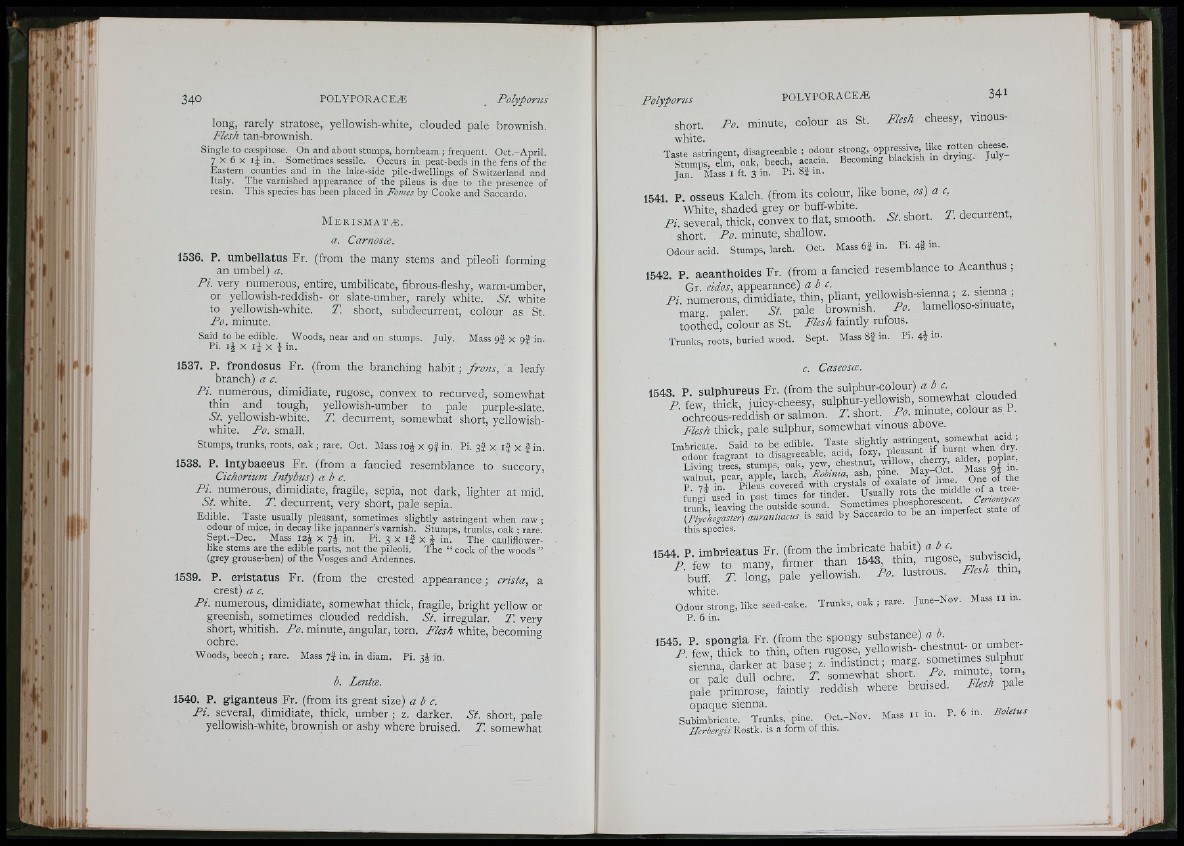
( te
,'‘l "
♦# J
i» I
340 POLYPORACEÆ Polyporus
long, rarely stratose, yellowish-white, clouded pale brownish.
Flesh tan-brownish.
Single to cæspitose. On and about stumps, hornbeam ; frequent, Oct.-April.
7 X 6 X I® in. Sometimes sessile. Occurs in peat-beds in the fens of thé
Eastern counties and in the lake-side pile-dwellings of Switzerland and
Italy. The varnished appearance of the pileus is due to the presence of
resin. This species has been placed in Femes by Cooke and Saccardo.
M e r i s m a t æ .
a. Carnosce.
1536. P. umbellatus Fr. (from the many stems and pileoli forming
an umbel) a.
Pi. very numerous, entire, umbilicate, fibrous-fleshy, warm-umber,
or yellowish-reddish- or slate-umber, rarely white. St. white
to yellowish-white. T. short, subdecurrent, colour as St.
Po. minute.
Said to be edible. Woods, near and on stumps. July. Mass qj x q | in.
Pi. I® X I® X i in.
1537. P. frondosus Fr. (from the branching habit; frons, a leafy
branch) a c.
Pt. numerous, dimidiate, rugose, convex to recurved, somewhat
thin and tough, yellowish-umber to pale purple-slate.
Ä. yellowish-white. T. decurrent, somewhat short, yellowish-
white. Po. small.
Stumps, trunks, roots, oak ; rare. Oct. Mass 10® X g f in. Pi. 3I X i | X | in.
1538. P. intybaeeus Fr. (from a fancied resemblance to succory,
Cichorium Intybus) abc.
Pi. numerous, dimidiate, fragile, sepia, not dark, lighter at mid.
St. white. T. decurrent, very short, pale sepia.
Edible. Taste usually pleasant, sometimes slightly astringent when raw ;
odour of mice, in decay like japanner’s varnish. Stumps, trunks, oak ; rare
Sept.-Dee. Mass 12® x 7® in. Pi. 3 x i f X ® in. The cauliflower-
like stems are the edible parts, not the pileoli. The “ cock of the woods ”
(grey grouse-hen) of the Vosges and Ardennes.
1539. P. eristatus Fr. (from the crested appearance; crista, a
crest) a c.
Pi. numerous, dimidiate, somewhat thick, fragile, bright yellow or
greenish, sometimes clouded reddish. St. irregular. T. very
short, whitish. Po. minute, angular, torn. Flesh white, becoming
ochre.
Woods, beech ; rare. Mass 7f in. in diam. Pi. 3® in.
b. Lentoe.
1540. P. giganteus Fr. (from its great size) abc .
Pi. several, dimidiate, thick, umber ; z. darker. St. short, pale
yellowish-white, brownish or ashy where bruised. T. somewhat
Polyporus POLYPORACEÆ 341
short. Po. minute, colour as St. Flesh cheesy, vinouswhite.
Jan. Mass I ft. 3 in. Pi. 8f in.
1541. P. o ss eu s Kalch. (from its colour, like bone, os) a c,
White shaded grey or buff-white.
Pi. several, thick, convex to flat, smooth. St. short. T. decuiren ,
short. Po. minute, shallow.
Odour acid. Stumps, larch. Oct. Mass 6| in. Pi. 4§ « •
1542. P. aeanthoides Fr. (from a fancied resemblance to Acanthus ;
Gr. eidos, appearance) abc . „ . , . , •
Pi. numerous, dimidiate, thin, pliant, yellowish-sienna; z^ slenn
marg. paler. St. pale brownish. Po. lamelloso-sinuate,
toothed, colour as St. Flesh faintly rufous.
Trunks, roots, buried wood. Sept. Mass 8f in. Pi. 4 i « •
c. Caseosa.
1543 P s u ln h u r e u s Fr. ( from the sulphur-colour) a i A
> ¿w tMck juicy-cLesy, sulphur-yellowish, somewhat clouded
o L r L u L e d k h or salmon, r . short, i ’f. minute, colour as P.
Flesh thick, pale sulphur, somewhat vinous above.
Imbricate. Said to be edible Taste
(Ptychogaster) aurantiaeus is said by Saccardo to be an p
this species.
buff. T. long, pale yellowish. Po. lustrous. Flesh thm,
O d i l l o n g , like seed-cake. Trunks, oak ; rare. June-Nov. Mass II in.
P. 6 in.
1 5 4 5 P S D O n g ia Fr. (from the spongy substance) a b.
> few tMck to thin, often rugose, yellowish- chestnut- or umbe -
^ •sfeL rd a rk e r a t base; z. indistinct; marg.
or pale dull ochre. T. somewhat short. Po^ mnmte tom
pale primrose, faintly reddish where bruised. Flesh pale
opaque sienna.
Subimbricate. Trunks, pine. Oct.-Nov. Mass I I m. P. m. 0 e us
Herhergii Rostk. is a form of thts.
' 141